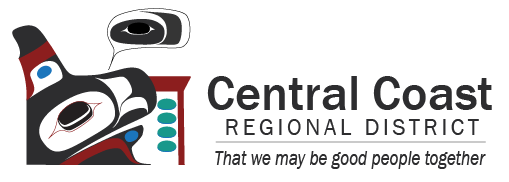The Emergency Planning function is shared by all electoral areas in the Regional District pursuant to the "Emergency Measures Establishing Bylaw" and the "Emergency Measures Regulatory Bylaw", both of which were enacted in 2000. The bylaws were adopted to provide a comprehensive management program to prepare for, respond to and recover from emergencies and disasters. The Central Coast Regional District is a local authority in accordance with the provincial Emergency Program Act.
The Central Coast Regional District Emergency Management Organization is comprised of the Emergency Executive Committee and such other persons appointed and functional groups established. They are charged with emergency preparedness, and response and recovery measures. The emergency coordinator resides in Bella Coola; there are two deputy coordinators who reside in the communities of Denny Island and Ocean Falls. The Emergency Executive Committee is composed of a Board Director who is also the Committee Chair, a Secretary, the Emergency Coordinator, and a representative from the Nuxalk Nation.
In 2005, the Regional District began to undertake the generation of emergency plans for all electoral areas. All plans are consistent with the British Columbia Emergency Response Management System (BCERMS) and are designed to address the main hazards and threats to the various communities in a practical manner that acknowledges local conditions and availability of emergency response resources. The plans are comprehensive in nature, but are not meant to cover every conceivable emergency situation. The goal of the plans is to provide a flexible system that can reasonably be expected to help minimize injury and property damage.
Emergency plans are also structured to: firstly, to minimize hazards and threats; secondly, to establish general emergency response procedures; and thirdly, to provide specific plans for the main emergency threats anticipated in each area. The plans have been prepared to provide key individuals, agencies and businesses with a general guideline in the initial response to an emergency or disaster and an overview of their responsibilities while the emergency exists.
According to the British Columbia Emergency Response Management System model, the prescribed set of response goals for emergency personnel, in order of priority are:
| a) | Provide for the safety and health of responders; |
| b) | Save lives; |
| c) | Reduce suffering; |
| d) | Protect public health; |
| e) | Protect government infrastructure; |
| f) | Protect property; |
| g) | Protect the environment; and |
| h) | Reduce economic and social losses |
Recovery programs are designed to help restore the community and its environment to pre-emergency condition. They include measures such as physical restoration and reconstruction, economic impact studies, counselling, financial assistance programs, temporary housing, and health and safety information.
The emergency plans provide a contact list and plans for communication, evacuation, emergency social services, fire emergency, flood emergency, landslide, tsunami, earthquake, weather storm, disease and epidemics, explosion and hazardous material spill, power outage and other emergencies. They also provide information regarding the Disaster Financial Assistance Program as offered by the provincial government.
Emergency Social Services (ESS) is a program that provides short term disaster relief to those affected by emergency situations. It depends on community volunteers to plan and provide for the essential needs of individuals, families and response workers and may include food, lodging, clothing, emotional support, financial aid, and finding loved ones. Through the ESS plan, communities can improve their ability to cope with disaster by establishing the network of volunteers and developing liaisons with businesses, organizations and service providers willing to share resources in times of trouble.
As components of the Emergency Planning function, Community Wildfire Protection Plans have been completed for the Central Coast communities of Bella Bella, Bella Coola, Denny Island, Ocean Falls and Oweekeno village. Each plan includes a wildfire hazard assessment, interface fire planning units, emergency operations and a mitigation and action plan.
Central Coast Regional District Community Wildfire Protection Plan.
- Bella Bella Community Wildfire Protection Plan
- Bella Coola Community Wildfire Protection Plan
- Denny Island Community Wildfire Protection Plan
- Ocean Falls Community Wildfire Protection Plan
- Oweekeno Community Wildfire Protection Plan
